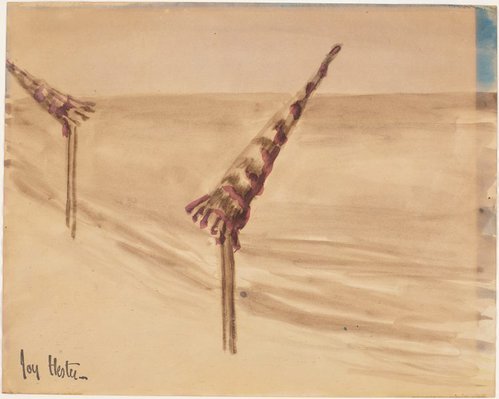-
Details
- Place where the work was made
-
Australia
- Date
- 1948-1949
- Media category
- Watercolour
- Materials used
- ink wash and watercolour on paper
- Dimensions
- 31.0 x 25.0 cm
- Credit
- Purchased with support of the Art Gallery Society of New South Wales through the Elizabeth Fyffe Bequest 2021
- Location
- Not on display
- Accession number
- 78.2021
- Copyright
- © Estate of Joy Hester/Copyright Agency
- Artist information
-
 Joy Hester
Joy Hester
Works in the collection
- Share
-
-
About
Joy Hester produced some of the most intriguing imagery to emerge in Australia during the 1940s and 1950s. The formative years of her practice in Melbourne from the late 1930s coincided with the tumultuous era of world conflict. Hester formed part of a group of young artists including Sidney Nolan, Albert Tucker and Arthur Boyd, who were intent on artistic change. Their works registered a profound shift in the traditions of figurative art in Australia.
Inscribed with an identity that merged social, intellectual, emotional and subconscious facets of the self, these artists collectively created a strange new repertoire of nervy bodies, distorting the figure to express the psychological dimensions of the self and to encompass the anxious, traumatic era of war. As an artist whose singular focus remained on the possibilities of representing the human form, Hester, although largely unrecognised outside of her artistic peers during her lifetime, was at the forefront of this revolution.
In Melbourne’s wartime milieu, Hester established the distinctive terms of her practice. She adopted ink drawing over painting as her primary medium and, harnessing the feel for transience that came with it, creating turbulent psychological portraits. She produced a vast and varied body of drawings during the war but often returned to figurative motifs of isolation and enclosure. By the late 1940s she had further stripped her subjects bare, inflating the eyes to the point that they stood for the figure and created dark, tormented enigmas of a confined self.
By 1948 there was an emotional recalibration in Hester’s work as she embarked on her exceptional Lovers series of drawings which she continued to work on throughout the 1950s. Hester has replaced her earlier tormented imagery with recurring motifs of lovers’ merging bodies, often an ethereal female and darker, sometimes shadowy male presence. The eyes remained central as a compositional device melding the figures, and a motif used to project both desire and disturbance of such closeness.
Lovers 1948-49 is one of the formative works in this series. It is an energised affirmation of love, connection and sexual union. But Hester’s works are never entirely straightforward, and in Lovers 1948-49 there is an uneasy sense of the individual being consumed, negated by closeness, a lurking apprehension that would become fully pronounced in later works of this series.
Lovers 1948-49 beautifully characterises Hester’s capacity to create strange figurations, formed by her unique expression of the rigours of the psyche. She does so here with minimal but varied mark making; the “nervous line”, as artist Ken Whisson once described it, with which she renders her eyes, and the bold, inky contours that bind her figures.
When Hester first exhibited examples of her Lovers drawings, along with her earlier Faces and Sleep series in her first solo exhibition at Melbourne’s Bookclub Gallery in the 1950s, critics found them too ‘personal’ and their meaning ‘lost in obscurity’. Not a single work sold. Today Hester’s Lovers works are understood as the most significant of her career, and among the most evocative expressions of the psychological dimensions of human relationships ever created in Australian art.
-
Places
Where the work was made
Australia
-
Exhibition history
Shown in 1 exhibition
20th-Century galleries, ground level (rehang), Art Gallery of New South Wales, Sydney, 20 Aug 2022–2023





